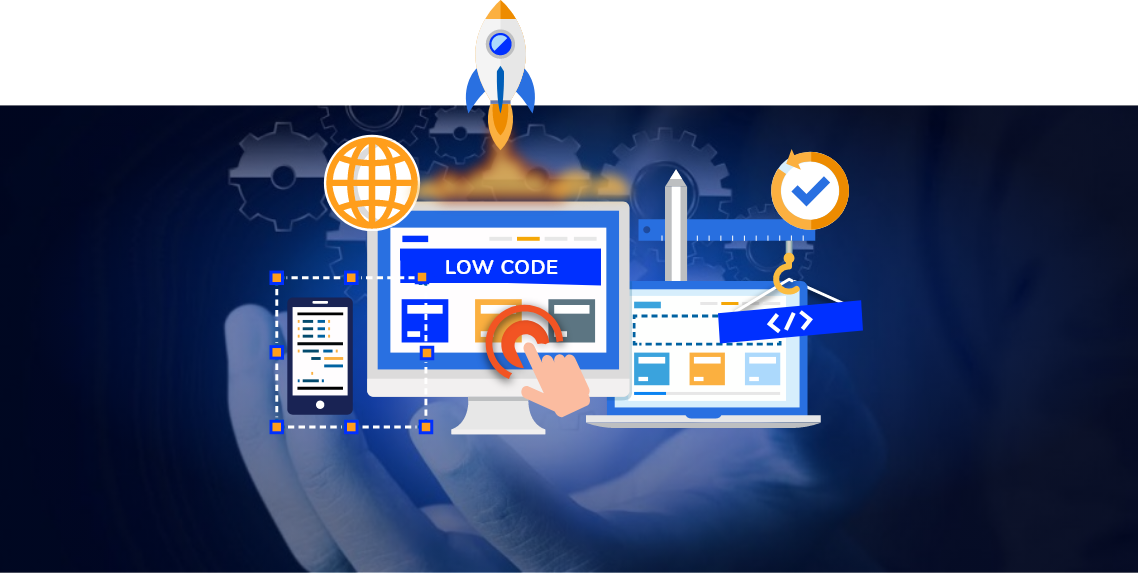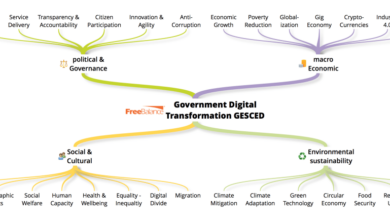
Benefits of Low Code for Hyper-Connected Enterprises
Benefits of low code platform for hyper connected enterprise – Benefits of Low Code Platform for Hyper-Connected Enterprises: In today’s rapidly evolving digital landscape, businesses are grappling with the need to build and deploy applications faster than ever before. The hyper-connected nature of modern enterprises demands agility and adaptability, and that’s where low-code platforms step in as game-changers. These platforms empower organizations to streamline development, enhance collaboration, and ultimately gain a competitive edge in the market.
Let’s dive into how they achieve this.
Low-code platforms offer a revolutionary approach to application development, significantly reducing the reliance on traditional coding methods. This translates to faster development cycles, allowing businesses to respond quickly to changing market demands and internal needs. The visual development environments and pre-built components of these platforms also foster greater collaboration between IT professionals and business users, breaking down silos and accelerating the entire process.
But the benefits extend beyond speed and collaboration; low-code also contributes to cost optimization, enhanced security, and the empowerment of citizen developers within the organization.
Accelerated Development Cycles in Hyper-Connected Enterprises
In today’s hyper-connected business world, speed is everything. The ability to rapidly develop and deploy applications is crucial for staying ahead of the competition and capitalizing on emerging opportunities. Low-code platforms offer a powerful solution, dramatically accelerating development cycles within complex, interconnected enterprise environments. They achieve this by simplifying the development process and empowering citizen developers, leading to faster time-to-market for critical applications.Low-code platforms significantly reduce development time by abstracting away much of the complex coding required in traditional software development.
This allows developers to focus on the core business logic and functionality, rather than getting bogged down in intricate coding details. The visual, drag-and-drop interfaces, pre-built components, and automated processes inherent in these platforms streamline the entire development lifecycle.
Features Contributing to Faster Development
Several key features within low-code platforms contribute to significantly faster development cycles. These features collectively reduce the time spent on repetitive tasks and allow for rapid prototyping and iteration.
- Visual Development Environments: Low-code platforms utilize intuitive, drag-and-drop interfaces, enabling developers to visually design and build applications without extensive coding. This eliminates the need for writing lengthy lines of code for basic functionalities, saving considerable time.
- Pre-built Components and Templates: A vast library of pre-built components, such as user interfaces, data connectors, and business logic modules, accelerates development by providing ready-to-use building blocks. Developers can simply drag and drop these components into their applications, eliminating the need to build everything from scratch.
- Automated Processes: Many low-code platforms automate tasks such as code generation, testing, and deployment. This automation minimizes manual effort and reduces the risk of human error, further speeding up the development process.
- Integrated Development Environment (IDE): A unified IDE combines all the necessary tools and resources in one place, streamlining workflows and eliminating the need to switch between different applications. This consolidated approach improves developer efficiency and reduces context switching time.
Hypothetical Scenario: Low-Code vs. Traditional Development
Let’s imagine a scenario where a hyper-connected enterprise needs a simple mobile application to track inventory levels across multiple warehouses in real-time. Using traditional methods, a team of developers might spend weeks, even months, on planning, coding, testing, and deployment. This would involve extensive coding in languages like Java or Python, designing databases, setting up servers, and conducting rigorous testing.However, with a low-code platform, the same application could be developed and deployed in a matter of days.
The development team could utilize pre-built components for the user interface and data integration, leverage drag-and-drop functionality to design the application’s workflow, and rely on the platform’s built-in testing and deployment capabilities. The reduced complexity and automated processes drastically reduce development time.
Development Time Comparison: Low-Code vs. Traditional, Benefits of low code platform for hyper connected enterprise
The following table compares the development timelines for this simple inventory tracking application using low-code and traditional methods:
| Method | Task | Low-Code Time | Traditional Time |
|---|---|---|---|
| Low-Code | Requirement Gathering | 1 day | 3 days |
| Low-Code | UI Design & Development | 1 day | 7 days |
| Low-Code | Data Integration & Logic | 2 days | 14 days |
| Low-Code | Testing & Deployment | 1 day | 7 days |
| Traditional | Requirement Gathering | 3 days | 3 days |
| Traditional | Database Design | 5 days | N/A |
| Traditional | Backend Development | 10 days | N/A |
| Traditional | Frontend Development | 7 days | N/A |
| Traditional | Testing & Deployment | 7 days | N/A |
| Total | 5 days | 31 days |
Enhanced Agility and Adaptability: Benefits Of Low Code Platform For Hyper Connected Enterprise
In today’s hyper-connected world, businesses face constant pressure to adapt quickly to changing market conditions and customer demands. Low-code platforms offer a powerful solution by dramatically accelerating the development and deployment of applications, fostering a level of agility previously unimaginable. This enhanced agility translates directly into a competitive advantage, allowing organizations to respond swiftly to opportunities and threats.Rapid prototyping and iterative development are core strengths of low-code.
The visual development environment and pre-built components drastically reduce development time, enabling businesses to quickly build Minimum Viable Products (MVPs) and test them with real users. This iterative approach allows for continuous improvement and ensures that the final product perfectly aligns with evolving business needs.
Rapid Prototyping and Iterative Development
Low-code’s visual interface and drag-and-drop functionality enable developers, and even citizen developers, to quickly build and test prototypes. Imagine a scenario where a marketing team needs a new application to track campaign performance in real-time. Using a traditional coding approach, this might take weeks or even months. With a low-code platform, a prototype could be built and tested within days, allowing for early feedback and adjustments.
This iterative cycle of build-test-improve continues until the application meets the desired specifications. This approach minimizes the risk of developing a product that doesn’t meet market needs and significantly reduces wasted time and resources. For example, a retail company could rapidly prototype a mobile app for in-store order pickup, testing it with a small group of customers before rolling it out to a larger audience.
The feedback received during this process would inform future iterations and ensure a seamless customer experience.
Faster Response to Changing Market Demands
The speed and flexibility offered by low-code platforms are invaluable in responding to rapidly changing market demands. Consider a sudden shift in consumer preferences or the emergence of a new competitor. A traditional development process would struggle to keep pace, potentially resulting in lost market share. Low-code, however, allows businesses to quickly adapt their applications to address these changes.
For instance, if a new payment method gains popularity, a business can quickly update its e-commerce application to support it without extensive coding. Similarly, a sudden increase in demand for a specific product can be met by quickly deploying a new application to manage inventory and orders more efficiently.
Supporting Agile Methodologies
Low-code platforms are inherently aligned with agile methodologies. The iterative development cycle, continuous feedback loops, and rapid deployment capabilities are all hallmarks of agile development. The visual nature of low-code platforms also enhances collaboration between developers, business analysts, and stakeholders, ensuring everyone is aligned on the application’s goals and functionality. This collaborative approach speeds up the development process and increases the likelihood of delivering a successful product.
For example, daily stand-up meetings can easily incorporate progress updates on low-code application development, mirroring the typical agile workflow. The ability to quickly adapt to changing priorities is a key benefit of using low-code within an agile framework.
Adapting an Application Using a Low-Code Platform
This flowchart illustrates the process of adapting a low-code application in response to new requirements:[Diagram Description: A flowchart depicting the process begins with a “New Requirement Identified” box. An arrow leads to a “Requirement Analysis” box, followed by an arrow to “Design Changes in Low-Code Platform”. This leads to “Develop and Test Changes” then to “Deploy Updated Application”. A feedback loop connects “Deploy Updated Application” back to “New Requirement Identified” indicating continuous improvement and adaptation.
Finally, a branch from “Deploy Updated Application” goes to “Monitor Performance and User Feedback” which loops back to “Requirement Analysis”, demonstrating ongoing monitoring and iterative improvement.]
Improved Collaboration and Communication
Low-code platforms are revolutionizing how hyper-connected enterprises collaborate and communicate during software development. They break down traditional silos between developers, business users, and IT, fostering a more integrated and efficient workflow. This improved communication translates directly into faster development cycles, reduced errors, and ultimately, a more successful product launch.Low-code platforms dramatically alter the communication flow compared to traditional methods.
In traditional development, communication often relies on lengthy email chains, complex documentation, and potentially frustrating meetings to bridge the gap between technical and business teams. Misunderstandings are common, leading to delays and rework. Low-code, however, offers a visual, collaborative environment where everyone, regardless of technical expertise, can participate in the development process.
Visual Development Tools Enhance Understanding
Visual development tools are central to the improved communication facilitated by low-code platforms. Instead of relying on lines of complex code, users interact with drag-and-drop interfaces, visual models, and intuitive workflows. This visual representation allows business users to easily understand the application’s logic and functionality, fostering better collaboration with developers. For example, a business analyst can easily visualize the data flow in a new customer onboarding process using a visual workflow diagram, immediately identifying potential bottlenecks or areas for improvement.
This shared visual language significantly reduces the potential for misinterpretations that frequently occur with text-based code. Developers, in turn, can more easily understand the business requirements and translate them into functional applications, minimizing the back-and-forth communication typically required in traditional development.
Communication Strategies Enhanced by Low-Code Platforms
The use of a low-code platform significantly enhances several key communication strategies within a hyper-connected enterprise.
- Real-time Collaboration: Many low-code platforms offer real-time collaborative features, allowing multiple users to work on the same application simultaneously. This eliminates the need for version control conflicts and ensures everyone is working with the most up-to-date version of the application. Imagine multiple team members, including a business analyst, a developer, and a UI/UX designer, all working together on a single screen, modifying and refining the application in real-time.
- Centralized Communication Hub: Low-code platforms often incorporate integrated communication tools, such as chat functions and commenting features, directly within the development environment. This centralizes communication, ensuring all relevant discussions and updates are easily accessible to all team members.
- Improved Feedback Loops: The visual nature of low-code development makes it easier to provide and receive feedback. Business users can easily understand the application’s functionality and provide valuable input throughout the development process, leading to a faster iteration cycle and a more user-friendly final product. This continuous feedback loop is crucial in the fast-paced world of hyper-connected enterprises.
- Reduced Reliance on Formal Documentation: While documentation remains important, the visual nature of low-code development reduces the reliance on extensive, often outdated, written documentation. The application itself acts as a living document, readily accessible to all stakeholders.
Reduced Costs and Resource Optimization
Low-code platforms offer a compelling solution for hyper-connected enterprises seeking to streamline development and reduce operational costs. By significantly reducing the reliance on extensive hand-coding, these platforms unlock substantial savings across various aspects of application lifecycle management. This translates to a leaner, more efficient, and ultimately more profitable operation.Low-code platforms dramatically reduce development costs by minimizing the need for large teams of highly specialized and expensive programmers.
Instead of writing thousands of lines of code manually, developers can utilize pre-built components, drag-and-drop interfaces, and visual modeling tools to accelerate the development process. This results in faster time-to-market for new applications and features, allowing businesses to respond quickly to evolving market demands and gain a competitive edge. Furthermore, the reduced complexity inherent in low-code development minimizes the risk of costly errors and the need for extensive debugging, further contributing to cost savings.
Personnel Cost Savings
The shift from traditional coding to low-code development significantly impacts personnel costs. Smaller development teams can achieve the same—or even greater—results, reducing the need for large numbers of highly paid programmers and specialized testers. For example, a project that might have required a team of five experienced developers and two testers using traditional methods could potentially be completed by a team of two low-code developers and one tester.
This translates directly into reduced salaries, benefits, and training expenses. The reduced need for specialized skills also opens opportunities to upskill existing IT staff, leveraging their existing knowledge and reducing the cost of hiring external expertise.
Infrastructure and Maintenance Cost Savings
Low-code platforms often operate on cloud-based infrastructure, eliminating the need for significant upfront investments in hardware and on-premise servers. This reduces capital expenditure and simplifies infrastructure management. Moreover, the inherent simplicity of low-code applications leads to lower maintenance costs. Easier-to-understand code, coupled with built-in debugging and monitoring tools, simplifies troubleshooting and reduces the time and resources spent on resolving issues.
This contributes to a lower total cost of ownership (TCO) over the application’s lifecycle.
Total Cost of Ownership (TCO) Comparison
A comparison of TCO between low-code and traditional application development reveals significant advantages for low-code. While the initial investment might seem comparable in some instances, the long-term savings associated with reduced personnel, infrastructure, and maintenance costs significantly lower the overall TCO for low-code applications. Studies have shown that low-code applications can have a TCO that is 50-70% lower than those built using traditional methods, depending on the complexity of the application and the specific platform used.
For example, a complex enterprise resource planning (ERP) system built using traditional methods might cost millions of dollars over its lifecycle, while a comparable system built using a low-code platform could be developed and maintained for significantly less.
Specific Cost-Saving Measures Enabled by Low-Code Platforms
The cost benefits of low-code platforms are multifaceted. Let’s Artikel some specific cost-saving measures:
- Reduced development time and faster time-to-market.
- Smaller development teams with lower salary costs.
- Minimized need for specialized skills and expertise.
- Lower infrastructure costs due to cloud-based deployment.
- Simplified maintenance and reduced debugging efforts.
- Reduced risk of costly errors and rework.
- Improved operational efficiency through automation.
Scalability and Integration in a Hyper-Connected Environment

In today’s hyper-connected business world, the ability to scale applications rapidly and integrate them seamlessly with existing systems is paramount. Low-code platforms offer a significant advantage in this area, enabling enterprises to build applications that can handle explosive growth while effortlessly connecting to a diverse range of technologies. This allows for a more agile and responsive approach to business challenges, unlocking new opportunities and improving operational efficiency.Low-code platforms excel at building applications capable of handling increasing data volumes and user traffic.
Their inherent architecture often leverages cloud-based infrastructure, allowing for elastic scaling. This means applications can automatically adjust their resources (computing power, storage, bandwidth) based on demand, ensuring optimal performance even during peak usage. Unlike traditional development methods, which often require significant upfront planning and resource allocation, low-code allows for a more flexible and responsive approach to scaling. This translates to cost savings and reduced risk associated with unpredictable growth spurts.
Scalability of Low-Code Applications
The scalability of a low-code application depends on several factors, including the underlying platform’s architecture, the chosen deployment environment (cloud vs. on-premise), and the application’s design. However, the inherent modularity of low-code development allows for easier scaling compared to traditional methods. For instance, a low-code application processing customer orders might initially run on a single server. As order volume increases, the application can be seamlessly scaled to utilize multiple servers or leverage cloud-based autoscaling features, ensuring continued performance without requiring significant code changes or redevelopment.
This contrasts with traditional applications, which might necessitate complex re-architecting and extensive coding efforts to accommodate increased load. Real-world examples include e-commerce platforms built on low-code platforms that have successfully handled massive spikes in traffic during peak shopping seasons without experiencing significant performance degradation.
Seamless Integration with Enterprise Systems
Low-code platforms provide robust integration capabilities, enabling seamless connection with existing enterprise systems like CRM (Customer Relationship Management), ERP (Enterprise Resource Planning), and other specialized applications through APIs (Application Programming Interfaces). This integration is often facilitated through pre-built connectors and integrations, simplifying the process considerably. For example, a low-code application tracking inventory might directly integrate with the company’s ERP system to access real-time inventory data, eliminating the need for manual data entry and reducing the risk of errors.
This streamlined data flow enhances efficiency and provides a single source of truth across different systems.
Connecting Disparate Systems within a Hyper-Connected Enterprise
In a hyper-connected enterprise, data resides in numerous disparate systems. Low-code platforms play a crucial role in connecting these systems, creating a unified view of data and facilitating better collaboration and decision-making. They achieve this by providing a common platform for integrating various data sources, regardless of their underlying technology. Imagine a scenario where sales data resides in a CRM, marketing data in a marketing automation platform, and customer service data in a ticketing system.
A low-code application can integrate these disparate systems, providing a comprehensive view of the customer journey, enabling more effective marketing campaigns, and improving customer service.
Diagram Illustrating Low-Code Application Integration
Imagine a diagram showing a central low-code application at the heart. Arrows point outwards connecting it to various enterprise systems represented by boxes. These boxes are labeled: CRM (Salesforce), ERP (SAP), Marketing Automation (Marketo), and a Database (e.g., MySQL). The arrows symbolize the flow of data between the low-code application and these systems. The diagram visually demonstrates how the low-code application acts as a central hub, integrating and orchestrating data from various sources.
This unified view empowers businesses to make informed decisions based on a complete picture of their operations.
Enhanced Security and Governance
In today’s hyper-connected world, security and governance are paramount. Low-code platforms, while accelerating development, shouldn’t compromise on these critical aspects. In fact, many modern low-code platforms offer robust features designed to enhance security and ensure compliance with industry regulations. This allows businesses to rapidly innovate while maintaining a strong security posture.Low-code platforms contribute significantly to enhanced security and compliance through several key mechanisms.
They often incorporate built-in security features that address common vulnerabilities, and provide tools to manage access control and data governance effectively. This approach minimizes the risk of human error and ensures consistent application of security best practices across the entire development lifecycle.
Built-in Security Features
Many low-code platforms include features like automated security scans, vulnerability detection, and built-in encryption. For example, a platform might automatically check for common vulnerabilities like SQL injection or cross-site scripting (XSS) during the development process, flagging potential issues before deployment. Data encryption both in transit and at rest is another common feature, protecting sensitive information from unauthorized access.
These built-in features significantly reduce the burden on developers, allowing them to focus on application logic rather than low-level security implementation.
Access Control and Data Governance Measures
Effective access control is crucial for maintaining data security. Low-code platforms typically provide granular control over user permissions, allowing administrators to define who can access specific data and functionalities. This can include role-based access control (RBAC), where permissions are assigned based on a user’s role within the organization. Data governance features often include data masking and anonymization capabilities, enabling organizations to comply with data privacy regulations like GDPR and CCPA.
These features allow sensitive data to be used for development and testing purposes without exposing real user information. Furthermore, audit trails track all changes made to the application and data, providing a comprehensive record for compliance and security investigations.
Best Practices for Securing Low-Code Applications
While low-code platforms offer many built-in security features, adopting best practices is crucial for optimal security in a hyper-connected environment. Regular security audits are essential to identify and address potential vulnerabilities. Keeping the platform and its components updated with the latest security patches is paramount. Implementing strong password policies and multi-factor authentication (MFA) further strengthens security. Finally, regular security training for developers and users ensures everyone understands their responsibilities in maintaining a secure environment.
By combining the platform’s built-in security features with these best practices, organizations can significantly reduce their security risk.
Empowering Citizen Developers
In today’s hyper-connected enterprise, the demand for new applications and automated workflows far outpaces the capacity of traditional IT departments. This is where citizen developers step in, empowering business users with the tools to build and manage their own applications, significantly accelerating development cycles and driving innovation. Low-code platforms are the key to unlocking this potential, providing a bridge between business needs and technical implementation.Low-code platforms enable business users to create and manage applications with minimal coding experience by providing a visual, drag-and-drop interface.
Instead of wrestling with complex code, citizen developers can focus on the business logic and user experience, using pre-built components and connectors to integrate with existing systems. This drastically reduces the time and resources required to develop applications, allowing for faster iteration and deployment of solutions.
Examples of Business Process Automation by Citizen Developers
Citizen developers, using low-code platforms, can automate a wide array of business processes. For instance, a marketing team might build an application to track campaign performance and automate email marketing sequences. A sales team could create an app to manage leads and automate follow-up communications. Human resources could develop an application to streamline onboarding processes or manage employee requests.
These are just a few examples; the possibilities are virtually limitless. The key is empowering business units to solve their own problems directly, without relying on a centralized IT department.
Citizen Developer Roles and Responsibilities
The following table Artikels different user roles and their level of involvement in low-code application development within a hyper-connected enterprise. This demonstrates how a collaborative approach, leveraging various skill sets, optimizes the development process.
| Role | Responsibilities | Required Skills | Example Tasks |
|---|---|---|---|
| Citizen Developer (Business User) | Design, build, and maintain simple applications addressing specific business needs. | Basic understanding of business processes, familiarity with the low-code platform’s interface. | Creating a simple expense report submission application, automating email notifications for order updates. |
| Power User (Advanced Business User) | Develop more complex applications, integrate with multiple systems, and handle advanced functionalities. | Strong understanding of business processes, experience with data modeling and integration, proficiency in the low-code platform’s advanced features. | Developing a CRM integration with the company’s marketing automation platform, creating custom workflows and reports. |
| IT Professional (Developer/Administrator) | Provide support, guidance, and governance for citizen developers. Ensure application security and compliance. Manage the low-code platform’s infrastructure. | Strong programming skills, deep understanding of IT security and compliance, experience with low-code platform administration. | Setting up and managing the low-code platform environment, providing training and support to citizen developers, ensuring data security and compliance. |
| IT Architect | Define the overall architecture and governance for low-code application development within the organization. Ensure interoperability and scalability of applications. | Extensive experience in enterprise architecture, deep understanding of integration technologies, experience with low-code platform architecture. | Defining standards and guidelines for low-code application development, ensuring seamless integration with existing systems, planning for future scalability and expansion. |
Concluding Remarks

In conclusion, the adoption of low-code platforms is no longer a luxury but a necessity for hyper-connected enterprises. The ability to accelerate development cycles, enhance agility, improve collaboration, reduce costs, and empower citizen developers provides a significant competitive advantage in today’s fast-paced business world. By leveraging the power of low-code, businesses can unlock unprecedented levels of efficiency and innovation, ultimately driving growth and success.
The future of application development is clearly low-code, and those who embrace it will be best positioned to thrive.
FAQ Insights
What are the security risks associated with low-code platforms?
While low-code platforms offer many security features, risks can still exist if not properly managed. Thorough security assessments, access control implementation, and adherence to best practices are crucial. Choosing a reputable platform provider with robust security measures is also vital.
Can low-code platforms handle complex enterprise applications?
Yes, many low-code platforms can handle complex applications. While they excel at rapid development of simpler apps, their capabilities are constantly expanding to address more sophisticated needs. However, extremely complex projects might still require some traditional coding.
What kind of training is needed for citizen developers using low-code platforms?
The training required varies depending on the platform and the complexity of the applications being built. However, many platforms offer intuitive interfaces requiring minimal technical expertise. Often, short online courses or internal training sessions suffice.
How do I choose the right low-code platform for my business?
Consider factors like scalability, integration capabilities with existing systems, security features, ease of use, and the specific needs of your business. Evaluate different platforms through demos and trials to find the best fit.





